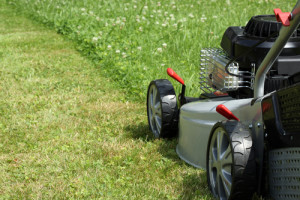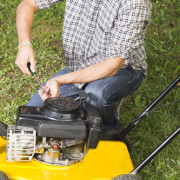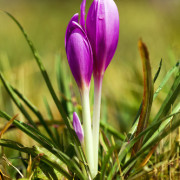Top 5 Tips for Spring Lawn Care
Spring is such a promising time of year, with so much colour returning to the land. Flowers are blossoming, speckling the landscape with pops of colour! Our lawns are also returning to life, and the sound of lawn mowers is present in many neighbourhoods on the weekend. Spring is the time when homeowners begin to work on their summer lawns, because healthy grass starts with proper care in the spring.
The soil in our yards is altered by winter weather, compacted by snow, frost, and rain, and the pH levels are higher, which makes your lawn a friendly place for weeds and disease. Spring is a critical time to care for your lawn, cleaning it up, applying fertilizer, and properly mowing early in the season. With the proper care now, you’ll have a lush lawn to enjoy in the months to come.

 To start, give your lawn a light raking once the ground has dried out to clean any debris off the lawn, then inspect it for problem areas. Common lawn troubles include thatching, soil compaction, and uneven ground.
To start, give your lawn a light raking once the ground has dried out to clean any debris off the lawn, then inspect it for problem areas. Common lawn troubles include thatching, soil compaction, and uneven ground.
Thatching occurs when large amounts of dead grass gather just above the soil, preventing your lawn from getting adequate moisture and air. This can be overcome with a specially designed rake that combs the grass and leaves debris that can be manually raked up afterward. Depending on the variety of grass in your lawn, dethatching should be done either in early spring or late summer.
High-traffic areas of your lawn may suffer from soil compaction, where the soil is densely packed. This makes it challenging for grass to take root, and instead, weeds take over because their roots are hardier than grass. Aerating solves this, which pulls small plugs out of the soil, allowing air and water to reach the roots of the grass. Aerating is less stressful on your lawn than dethatching is.
Uneven ground in your lawn leaves some areas susceptible to being scalped by the lawn mower blade in higher areas, and poor drainage in low areas. Even your lawn out by cutting raised areas away with a shovel, and filling in the depressed areas.
 Once you’ve fixed any problem areas, if any, reseed areas that are bare or brown. Larger areas should be seeded using a broadcast spreader, whereas smaller areas can be reseeded by hand. Be sure to choose a variety of grass that works for your climate, sun/shade levels in your yard, and be sure to water it regularly.
Once you’ve fixed any problem areas, if any, reseed areas that are bare or brown. Larger areas should be seeded using a broadcast spreader, whereas smaller areas can be reseeded by hand. Be sure to choose a variety of grass that works for your climate, sun/shade levels in your yard, and be sure to water it regularly.
 Now that your lawn is back to shape, you can fertilize to help it grow thick and lush. Choose a slow-release nitrogen fertilizer and apply early in the season using a broadcast spreader. Follow the package directions for when and how much to apply, and how much you should water your lawn after you’ve applied the fertilizer.
Now that your lawn is back to shape, you can fertilize to help it grow thick and lush. Choose a slow-release nitrogen fertilizer and apply early in the season using a broadcast spreader. Follow the package directions for when and how much to apply, and how much you should water your lawn after you’ve applied the fertilizer.
 As soon as your lawn needs it, mow it, but avoid the urge to cut it too low. Grass blades do best when only a third of the blade’s length is cut at a time. Leaving the lawn longer allows the blades of grass to absorb more sunlight and shade the soil, which helps grass growth and deters weed growth. The variety of grass you have will determine what height is recommended for your lawn.
As soon as your lawn needs it, mow it, but avoid the urge to cut it too low. Grass blades do best when only a third of the blade’s length is cut at a time. Leaving the lawn longer allows the blades of grass to absorb more sunlight and shade the soil, which helps grass growth and deters weed growth. The variety of grass you have will determine what height is recommended for your lawn.
 Once your lawn is growing again for the season, and especially after seeding, make sure your lawn is getting at least 1″ of water per week, but always follow the watering guidelines for your region in the drier months. Many communities begin water restrictions in April, so contact your local regional district for details if you’re unsure.
Once your lawn is growing again for the season, and especially after seeding, make sure your lawn is getting at least 1″ of water per week, but always follow the watering guidelines for your region in the drier months. Many communities begin water restrictions in April, so contact your local regional district for details if you’re unsure.
There are many local companies that can provide you with assistance in lawn care, either on a maintenance plan or as needed. Check out a Home Show in your area to meet local providers!











